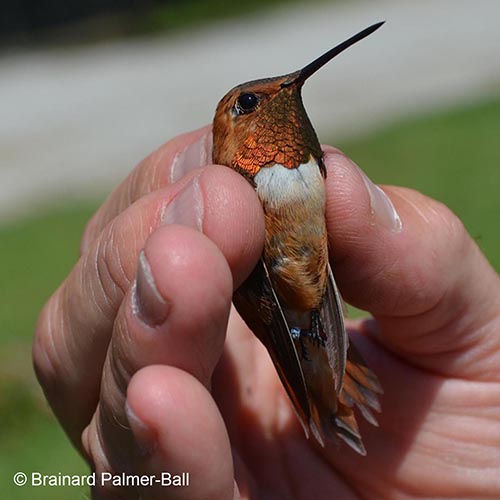
Listen to this Episode:
- From this webpage:
- Find the media player located under the episode picture.
- Click on the green triangle to listen to the audio for this episode.
- From your favorite podcast listening platform:
- Search for “Backyard Ecology.”
Show notes:
We always think of hummingbirds as being summer birds. But, did you know that we also have winter hummingbirds? They aren’t common, and they become less common the further you are from the southern coastal plains; however, they aren’t unique either. In the winter of 2011-2012, I was lucky enough to host one of these winter hummingbirds at my home in Kentucky.
In this Backyard Ecology episode, I talk with Brainard Palmer-Ball about these winter hummingbirds. Brainard is a retired zoologist from the Office of Kentucky Nature Preserves. He’s also the person who captured and banded my winter hummingbird in 2011.
In the eastern U.S., our winter hummingbirds aren’t the familiar ruby-throated hummingbirds that we see all summer. Instead, most of the hummingbirds that overwinter in the eastern U.S. are western species. There are a handful of western species that sometimes spend the winter in the eastern U.S., but the most common one is the rufous hummingbird.
It is thought that we probably always had a few winter hummingbirds, but we just didn’t notice them. Then as hummingbird feeding increased in popularity in the 80s and 90s, more available food sources and more eyes watching those food sources meant that we became more aware of this phenomenon. These food sources aren’t drawing the winter hummingbirds or encouraging them to overwinter where they shouldn’t, but they are potentially improving survival chances during the worst parts of our winters.
In our conversation, Brainard and I talk in more detail about our winter hummingbirds, how they aren’t “lost,” as was once thought, and how they survive through the winter. We also discuss the importance of feeders and tackle the question of whether leaving our feeders up, or putting them back out for late hummingbirds, is a good thing. In addition, we talk about banding hummingbirds and what can be learned from that process. Of course, Brainard also shares with us what we need to think about and do if we are lucky enough to have one of these winter hummingbirds show up at our homes.
Links:
- Operation Ruby Throat
- Hummingbird Research, Inc.
- Southeastern Avian Research
- Report a bird band
- Hummer’s Heated Delight
- Backyard Ecology’s website
- Backyard Ecology blog – https://www.backyardecology.net/blog/
- Backyard Ecology’s Patreon page – https://www.patreon.com/backyardecology
- Subscribe to Backyard Ecology emails – https://www.backyardecology.net/subscribe/
- My email: shannon@backyardecology.net
Episode image:
- Rufous hummingbird that Brainard banded in Kentucky.
- Photo credit: Brainard Palmer-Ball, all rights reserved

Backyard Ecology: Exploring Nature in Your Backyard
Nature isn’t just “out there.” It’s all around us, including right outside our doors. Hi, my name is Shannon Trimboli, and I am the host of Backyard Ecology. I live in southcentral Kentucky and am a wildlife biologist, educator, author, beekeeper, and owner of a nursery specializing in plants for pollinators and wildlife conservation. I invite you to join me as we ignite our curiosity and natural wonder, explore our yards and communities, and improve our local pollinator and wildlife habitat. Learn more or subscribe to my email list at www.backyardecology.net.

Leave a Reply